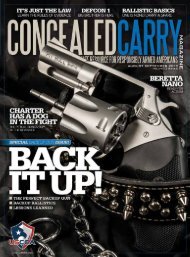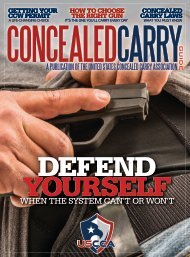Create successful ePaper yourself
Turn your PDF publications into a flip-book with our unique Google optimized e-Paper software.
FEATURE STORYFinal Intense Scenario Training (F.I.S.T.)is designed for students who havecompleted the Tactical Defense Institute’s(TDI’s) Level VI handgun course. The classruns two days and involves numerous livefire and force-on-force (FOF) scenariosthat are run with Airsoft and Code-Eagle ®guns. In addition, the TDI instructors workwith the students on any problems thatthey are having either with their guns ortheir shooting skills. The class is offeredevery two years. Nineteen studentsattended this year’s class, which wassupported by 6 instructors and 12 to 15role players.I had a chance to talk with JohnBenner, the president of TDI, about thegoals of F.I.S.T. Mr. Benner designed thecourse to allow high level students to getadditional scenario-based training andto practice skills that were learned in theprevious 6 levels of handgun training. Healso wanted to update students on recentdevelopments in personal defensivetactics. The results of the scenarios areused to assess the TDI teaching methodsand content. The instructors all havecareers in law enforcement and theycritique the results of each scenario withinthe framework of the law and tactics. Thedesign of the realistic live fire and FOFscenarios ranged from the simple to thecomplex, but they were not unsolvableby the student. What the student gets outof F.I.S.T. depends on how willing thestudent is to learn and participate in thescenario. In each scenario, the studenthas several options to choose from forthe solution, based on how he sees thescenario unfold.John Benner and TDI have beendoing live fire and FOF training for the last20 years. FOF started with .38 caliber,primer fired, softened wax bullets thatwere fired from .38 caliber handguns.Today they use Airsoft guns and Code-Eagle rounds (38. caliber, primer fired,paint marking bullets). Live fire scenariostake place in two live fire houses and onthe range using range cars. The TDI livefire houses are built into shooting bermswhich become three sides of the house.The fourth side of the house is designedso that no bullet leaves the house. Thehouses are “furnished” with simplewooden mock-ups of furniture. That wayan errant bullet doesn’t destroy the props.For example, the bad guy (or gal) canhide behind a wooden mock-up of a TVjust as easily as they can hide behind thereal thing. Each day was divided up intothree segments: live fire practice on thelower range, live fire house exercises,and FOF scenarios. In addition, onehandedmalfunction drills were taughtand practiced.LIVE FIRE PRACTICEJust to get our blood moving a littlefaster, the first shot of the day was timedfrom the chest ready (or chest retention).The distance was seven yards and theplates were 12 inches square. The timesran from about 0.6 seconds to about 1.2seconds. Then we were timed on one shoton each of three plates, at about five feetapart. The times here ranged from about1 to 2 seconds. Warm up continued onthe steel plates for about 250 rounds.Since all of the students were high levelstudents, each was left to devise his orher own warm up routine. We wereencouraged to take a series of singleshots on the plates and then engagemultiple plates. We practiced from thechest retention position and from theholster, with and without a concealmentgarment. When each student finishedhis drill, he scanned down-range forany more bad guys, then pulled back toa chest ready and “checked his world”(scanned 360 degrees around him forother bad guys). TDI instructors were16 <strong>Concealed</strong> <strong>Carry</strong> Magazine www.usconcealedcarry.comVolume 4 - May/June 2007
















